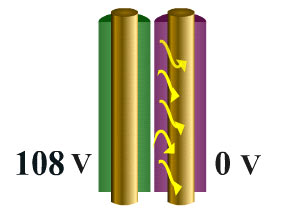Capacitance is the charge held by two conductors separated by a non-conductive barrier. The barrier divides the conductors and causes them to hold opposite charges (like a battery). Your cable may have capacitance you didn’t know about. Two wires separated by insulation can act as the conductors and barrier that create capacitance. As current flows through the wires, the charge is trapped in the unaccounted capacitance of the wires.
Unexpected capacitance can cause false failures in your cables. High voltage testing checks that the insulation is sufficient to stop current leakage. The tester cannot tell the difference between current leakage caused by capacitance or that caused by damage to the device. A test can fail from unexpected capacitance in the wires.
If you suspect your cable is failing from capacitance, Cirris has implemented features in some of its testers to help confirm or negate your suspicion.
All high voltage testers using easy-wire software can turn off high voltage on a given net or adjust parameters as needed. This lets you turn off high voltage on highly capacitive nets and still test the other nets with high voltage.
You can also program the tester to ignore a single over-current error and continue testing. Only use this feature if you suspect a high-capacitive shield is causing the failure. If the cable fails for other reasons, do not use this feature to help your cable pass.
You can learn more about Capacitance by following the link below.

Further Reading:
Resistance Is NOT Futile
What to Do if Your Cable Isn’t Passing
Testing Cables with a Twist